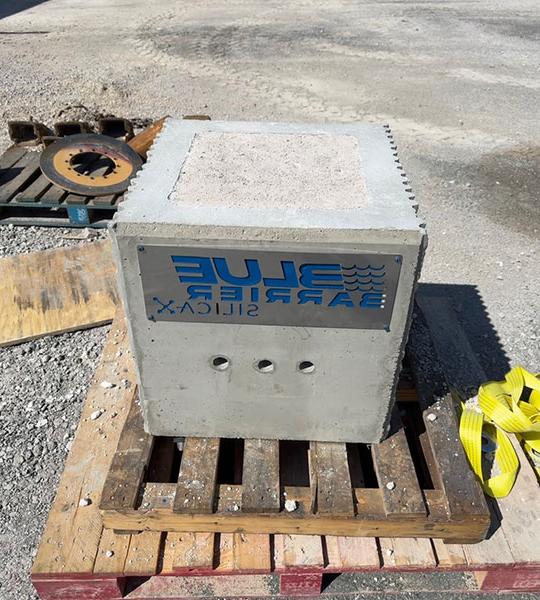Novel concrete developed at Alfred University to be tested against rigors of marine environment

Alfred University, in partnership with the New York State Department of Environmental Conservation (DEC) and U.S.-based company Silica-X, has developed a concrete fortified with waste glass particles which will be tested to learn how it holds up to the rigors of a marine environment.
The novel material has the potential to significantly reduce greenhouse gas emissions in the manufacture of concrete as well as the amount of waste glass going into landfills. In addition, it could be used in the manufacture of stronger, longer-lasting seawalls, protecting the world’s shorelines and infrastructure from rising sea levels.
A press conference is scheduled for Thursday, August 8, at 5 p.m., at The New York Aquarium (602 Surf Ave., Brooklyn, NY) to announce the results of the groundbreaking research at Alfred University. Representatives of Alfred University, including glass scientists in the Inamori School of Engineering, along with officials from Silica-X, New York State, and the DEC, will be on hand to discuss the project.
Silica-X, is a Spokane, WA-based company specializing in the elimination of waste streams by using them to create economically desirable, planet-friendly materials from silica—the second-most abundant compound on Earth. The company develops technology and systems that enable industry to reclaim hundreds of millions of tons of industrial waste each year, turning it into valuable resources.
In the fall of 2022, glass scientists at Alfred University, led by Collin Wilkinson, assistant professor of glass science—in partnership with New York State and Silica-X—began researching ways to develop a novel concrete made from cement fortified with waste glass particles. The research is supported by the DEC, which awarded Alfred University $4.2 million from its Environmental Protection Fund. Funding supports research, in partnership with private enterprise, aimed at promoting glass recycling and reuse.
One of the goals of the glass sustainability program is to develop new “sinks,” or products which make use of recycled glass. The collaboration between Alfred University and Silica-X studies how waste glass particles can be used in place of traditional materials (finely powdered stone) used in the production of cement. The process of making traditional Portland cement is a major contributor to greenhouse gasses worldwide; using alternative materials, such as waste glass, in creating cement is less harmful to the environment. This innovation can best be described as the first ever Roman Concrete analog – with significantly longer life spans and reduced material weight as compared to traditional concrete widely manufactured today.
The broader goal of the glass recycling research being conducted at Alfred University is to find ways to significantly stimulate a “circular economy,” one in which waste products—in this case glass—are put to use, rather than simply buried.
“The circular economy means we use what we produce,” Wilkinson said. “If we produce waste, we have to figure out how to use it. We have this excess glass here, and over here we have this problem with sea walls.”
Researchers believe the novel concrete will stand up to the rigors of a marine environment better than concrete made from Portland cement. It could potentially be used in the production of stronger, longer-lasting sea walls along the world’s coastlines, further helping the environment.
Samples of this Roman-derived concrete made from glass-fortified cement—in the form of four cubic foot blocks called “coupons”—will be placed in the Long Island Sound in early October to test its robustness in the marine environment. The coupons will be studied regularly for two years.
“We’re excited for the launch of these coupons,” said Gabrielle Gaustad ’04, dean of the Inamori School of Engineering and associate provost for Research at Alfred University. “They will be monitored by a team to see how they stand up structurally and how they work with the local ecology.”
The test coupons are designed to encourage sea life propagation, supporting ocean ecology. It is further anticipated that manufacturing of this innovative concrete, by Silica-X, which has produced these initial test coupons, will be done locally, resulting in the creation of new, green jobs, while reducing the environmental impacts of shipping concrete to Long Island and waste glass off the Island.
While the immediate goal of the research focuses on self-healing concrete in seawater, “what will come from it has potential application in all green building materials,” said Philip Galland, CEO of Silica-X. If scientists are successful in creating a Roman Concrete analog, the materials could be used not just in sea wall construction, but in the construction of buildings in communities around the globe.
“This project represents a shared vision between Alfred University, and Silica-X,” Galland said. “This experiment is being done with a focus on the benefit of the citizens of New York. However, what is happening here is that we are creating a potential model that is going to positively impact the entire world.”
“Innovative partnerships like DEC’s work with Alfred University are critical to advance creative projects that illustrate the potential for a sustainable carbon future with materials already at our disposal,” DEC Interim Commissioner Sean Mahar said. “This project’s next phase will test the reuse of post-consumer glass waste and represents a significant opportunity to support greener approaches to shoreline, infrastructure, and economic resiliency along New York coastlines.”
